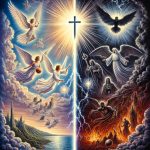A close look at the biblical accounts of creation reveals remarkable similarities and differences. We attempt here to listen carefully to the texts, compare and contrast them, and learn from and be enriched by them. This is not an either/or business, but both/and. The similarities and differences are our friends and will open new windows for our exploration.
Relevant Biblical Passages:
- The major accounts — Gen 1:1-2:25; Ps 104; Isa 40:12-31
- Wisdom’s role — Prov 8:22-36
- Divine dragon-slayer — Job 26:12-14; Ps 74:12-17; 89:8-13; Isa 51:9-10
Important Features of Creation Accounts in the Bible
In all the creation accounts in the Bible certain features are common elements:
- -God is always the creator and is the central figure in the accounts
- -the earth and its inhabitants are the created order
- -the expected response from the people to these accounts is doxology and praise
- -there is an irrepressible sense that God’s creation is good, very good
- -there is a sense that order has come out of disorder and chaos
- -there is often an emphasis on encouragement and hope
There is also a wide range of variations in the accounts, reflecting different perspectives and emphases, different goals and objectives for God’s people, different lessons to learn. Note some of the differences between Gen 1:1-2:4a and Gen 2:4b-25:
| aspect | Gen 1 | Gen 2 |
| basic starting point | watery chaos | dry desert landscape |
| role of water | chaos and danger | needed and life-giving |
| literary style | more poetic, hymn-like | narrative, rustic, idyllic |
| name for God | Elohim (God) | Yahweh Elohim (Lord God) |
| means of creating | God speaks and makes | God forms, plants, constructs |
| order of creation | six-day order (people last) | man first, plants, animals, woman |
| picture of God | transcendent, powerful | immanent, close |
The passages dealing with God as dragon slayer (which pick up on a popular theme in the ancient world) make unmistakably clear that the God who created the world in the first place is more than able to handle any dragons confronting us today and bring order back into our lives.
Because of archaeological discoveries over the past several decades, we now have access to scores of creation accounts from the ancient world. The use of ancient pictures for creation in the Bible is two-fold: 1) they often appear so the Bible writer can say this is not so, but that God, the God of Israel, is the one who created the world and not one of the foreign gods and 2) they often provide the starting point for the biblical writer who carries the story or analogy in a new direction to demonstrate God’s ultimate power.
What Difference Does it Make?
So, what can we learn from these creation accounts about what was most important to the biblical writers (whatever we might consider most important)? What more do we know about creation and about God as creator?





